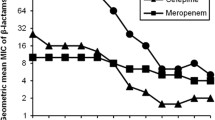Abstract
A series of experiments were performed withP. aeruginosa to demonstrate which of the biochemical mechanisms are responsible for the resistance to the β-lactam antibiotics. The constitutive β-lactamase was isolated and characterized for the strain used as type OXA whose pI was 7.1, with a molar mass of 49 kg/mol. The strain was also submitted to a series of treatments with Tris and Tris -EDTA to disrupt the outer membrane. The treated cells demonstrated a ten-fold reduction in the MIC with cloxacillin, six-fold with penicillin, and five-fold with oxacillin. At least two different biochemical mechanisms were responsible for the resistance to the β-lactams studied which could be important in the prevalence ofP. aeruginosa in nosocomial infections.
Similar content being viewed by others
References
Angus B.L., Caron A.M., Kropinski D.A., Hancock R.E.W.: Outer membrane permeability inPseudomonas aeruginosa: comparison of a wild-type with an antibiotics supersusceptible mutant.Antimicrob. Agents Chemother.21, 299–309 (1982).
Brzezinska M., Benveniste R.: Gentamicin resistance in strain ofPseudomonas aeruginosa mediated by enzymatic N-acetylation of the deoxystreptamine moiety.Biochemistry10, 1787–1795 (1972).
Colowick S.P., Kaplan N.D.:Enzyme Purification and Related Techniques, Vol. XXII. Academic Press, New York -London 1971.
Dale J.W., Smith J.T.: R-faetor mediated beta-lactamases that hydrolyse oxacillin; evidence for two distinct groups.J. Bacteriol.119, 351–356 (1969).
Fyfe J.A.M., Harris G., Govan J.R.M.: Revised pyocin typing method forPseudomonas aeruginosa.J.Clin. Microbiol.20, 47–50 (1984).
Hancock R.E.W., Decad G.M., Nikaido H.: Identification of the protein producing transmembrane diffusion pores in the outer membrane ofPseudomonas aeruginosa PAO1.Biochim. Biophys. Acta554, 324–331 (1979).
Irvin R.T., Costerton J.W.: Tris(hydroxymethyl)amino-methane buffer modification ofEscherichia coli outer membrane permeability.J. Bacteriol.145, 1397–1403 (1981).
Jacoby G.A., Mathew M.: The distribution of beta-lactamase genes on plasmid found inPseudomonas aeruginosa.Plasmid2, 41–47 (1979).
Janda J.M., Bottone E. J.:Pseudomonas aeruginosa enzyme prolifing; Predictor of potential invasiveness and use as an epidemiological tool.J. Clin. Microbiol.14, 55–60 (1981).
Luria S., Burrous J.W.: Hybridization betweenEscherichia coli andShigella.J. Bacteriol.74, 461–476 (1957).
Nicas T.I., Hancock R.E.W.: Outer membrane protein H1 ofPseudomonas aeruginosa involvement in adaptative and mutational resistance to ethylenediaminetetraacetate, polymyxin B and gentamicin.J. Bacteriol.143, 872–878 (1980).
Nicas T.I., Hancock R.E.W.:Pseudomonas aeruginosa outer membrane permeability: isolation of a porin protein-F deficient mutant.J. Bacteriol.153, 281–285 (1983).
Petras G.V., Bognar S.Z.: Origin and spread ofPseudomonas aeruginosa, Proteus andKlebsiella during twenty years in an infectious hospital.Acta Microbiol. Acad. Sci. Hung.28, 367–380 (1982).
Phehein L.C., Penn R.G., Sanders C.C., Georing R.V., Giegr D.H.: Emergence of resistance to beta-lactam and aminoglycoside antibiotics during moxalactam therapy ofPseudomonas aeruginosa infections.Antimicrob. Agents Chemother.22, 1037–1041 (1982).
Richmond M.H., Sykes R.B.: The β-lactamases of gram negative bacteria and their possible physiological role, pp. 31–88 inAdvances in Microbial Physiology (A.H. Rose, D.W. Tempest, eds), Vol. 9. Academic Press, London-New York 1973.
Sawai T., Takahashi I., Yamagishi S.: Iodometric assay method for beta-lactamase with various beta-lactam antibiotics as substrates.Antimicrob. Agents Ohemother.13, 1037–1041 (1978).
Scudamore R.A., Goldner M.: Limited contribution of the outer membrane penetration barrier toward intrinsic antibiotic resistance inPseudomonas aeruginosa.Can. J. Microbiol.28, 168–175 (1982).
Yamagushi A., Hiruma R., Sawai T.: Phospholipid bilayer permeability of beta-lactam antibiotics.J. Antibiotics35, 1692–1699 (1982).
Zimmermann W., Rosselet A.: Function of the outer membrane ofEscherichia coli as a permeability barrier to beta-lactam antibiotics.Antimicrob. Agents Chemother.12, 368–372; (1977).
Author information
Authors and Affiliations
Rights and permissions
About this article
Cite this article
Soto, U.L., Amadou, S.M., Ramos, F.J. et al. Resistance ofPseudomonas aeruginosa to β-lactam antibiotics. Folia Microbiol 32, 290–296 (1987). https://doi.org/10.1007/BF02877216
Received:
Revised:
Issue Date:
DOI: https://doi.org/10.1007/BF02877216




